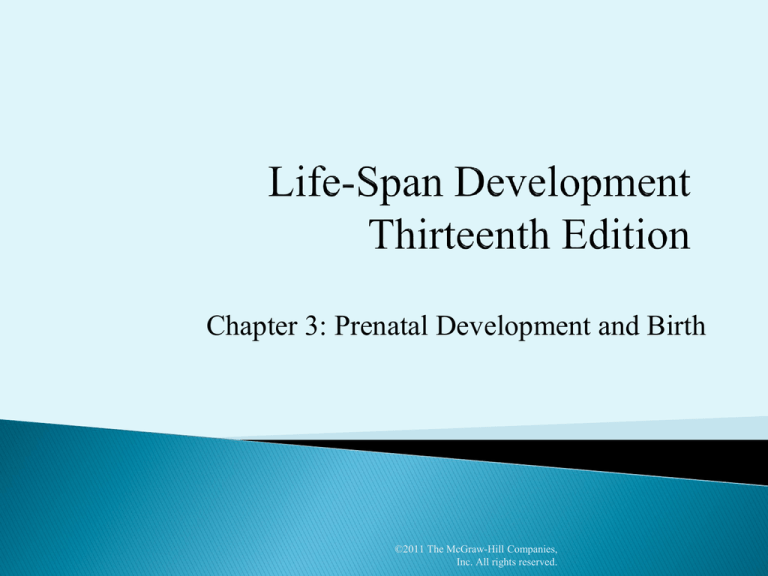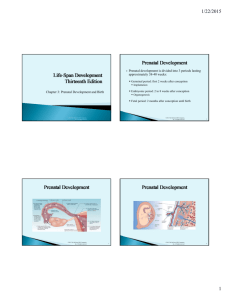
Chapter 3: Prenatal Development and Birth
©2011 The McGraw-Hill Companies,
Inc. All rights reserved.
Prenatal development is divided into 3 periods lasting
approximately 38-40 weeks:
Germinal period: first 2 weeks after conception
Implantation
Embryonic period: 2 to 8 weeks after conception
Organogenesis
Fetal period: 2 months after conception until birth
©2011 The McGraw-Hill Companies,
Inc. All rights reserved.
2
©2011 The McGraw-Hill Companies,
Inc. All rights reserved.
3
©2011 The McGraw-Hill Companies,
Inc. All rights reserved.
4
The Brain:
Babies have approximately 100 billion neurons (nerve cells) at
birth
Birth defects related to the brain when neural tube fails to close
Anencephaly
Spina bifida
In normal pregnancies, the neural tube closes creating
Neurogenesis: the generation of new neurons
Neuronal migration: cells move outward from their point of origin
to their appropriate locations
©2011 The McGraw-Hill Companies,
Inc. All rights reserved.
5
Teratology and Hazards to Prenatal Development
Teratogen: any agent that can cause a birth defect or negatively
alter cognitive and behavioral outcomes
Prescription and Nonprescription drugs
Psychoactive drugs
Fetal Alcohol Spectrum Disorders (FASD)
Incompatible blood types
Environmental hazards
Maternal diseases
Other parental factors
©2011 The McGraw-Hill Companies,
Inc. All rights reserved.
6
Teratology and Hazards to Prenatal Development
©2011 The McGraw-Hill Companies,
Inc. All rights reserved.
7
Prenatal Care
Screening for manageable conditions and treatable diseases
Educational, social, and nutritional services
CenteringPregnancy: relationship-centered program provides
complete prenatal care in a group setting
Home visitation – Nurse Family Partnership
©2011 The McGraw-Hill Companies,
Inc. All rights reserved.
8
Percentage of U.S. Women Using Timely
Prenatal Care: 1990 to 2004
1990
2004
100
90
80
70
60
50
40
30
20
10
0
African
Non-Latino American
White women
women
Latino
women
©2011 The McGraw-Hill Companies, Inc. All rights reserved. 9
The Birth Process
Stages of birth:
Stage 1: uterine contractions 15 to 20 minutes apart and last up to 1
minute
Stage 2: begins when the baby’s head starts to move through the
cervix and birth canal and ends when the baby completely emerges
from the mother’s body
Stage 3: afterbirth – umbilical cord, placenta, and other membranes
are detached and expelled
©2011 The McGraw-Hill Companies,
Inc. All rights reserved.
10
Childbirth Setting and Attendants:
In the U.S. 99% of deliveries take place in hospitals
In the U.S. 8% of births are attended by a midwife
In some countries, doulas provide continuous physical,
emotional, and educational support for mothers before,
during, and after childbirth
©2011 The McGraw-Hill Companies,
Inc. All rights reserved.
11
Methods of Childbirth
Medications:
Analgesia
Demerol
Anesthesia
Epidural block
Oxytocin
Synthetic hormones used to stimulate contractions
Natural childbirth
Prepared Childbirth
©2011 The McGraw-Hill Companies,
Inc. All rights reserved.
12
Other Methods of Childbirth
Waterbirth
Massage
Acupuncture
Hypnosis
Music therapy
Cesarean Delivery
©2011 The McGraw-Hill Companies,
Inc. All rights reserved.
13
Assessing the Newborn
Measuring neonatal health and responsiveness:
Apgar Scale: assessed at 1 minute and 5 minutes after
birth
A score of 0, 1, or 2 is given for each of the following: heart rate,
body color, muscle tone, respiratory effort, and reflex irritability
10 is highest, 3 or below indicates an emergency
©2011 The McGraw-Hill Companies,
Inc. All rights reserved.
14
Apgar Scale
©2011 The McGraw-Hill Companies,
Inc. All rights reserved.
15
Assessing the Newborn
Measuring neonatal health and responsiveness:
Brazelton Neonatal Behavioral Assessment Scale (NBAS):
Assesses newborn’s neurological development, reflexes, and
reactions to people and objects
Neonatal Intensive Care Unit Network Neurobehavioral
Scale (NNNS):
Assesses newborn’s behavior, neurological and stress responses,
and regulatory capacities
©2011 The McGraw-Hill Companies,
Inc. All rights reserved.
16
Preterm and Low Birth Weight Infants
Preterm and Small for Date Infants:
Low birth weight infants weigh less than 5 ½ lbs. at birth
Preterm infants are those born three weeks or more before full
term
Small for date infants are those whose birth weight is below
normal when the length of the pregnancy is considered
©2011 The McGraw-Hill Companies,
Inc. All rights reserved.
17
Preterm and Low Birth Weight Infants
Consequences of Preterm and Low Birth Weight Infants
Language development delays
Learning disabilities
ADHD
Asthma
Enrollment in special education programs
©2011 The McGraw-Hill Companies,
Inc. All rights reserved.
18
Preterm and Low Birth Weight Infants
Kangaroo care and massage therapy
Kangaroo Care: treatment for preterm infants that involves
skin to skin contact
Massage Therapy
©2011 The McGraw-Hill Companies,
Inc. All rights reserved.
19
Postpartum period lasts about six weeks or until the
mother’s body has completed its adjustment and has
returned to a nearly pre-pregnant state
Physical Adjustments:
Fatigue
Loss of Sleep
Hormone changes
Involution: the uterus returns to its pre-pregnant size
©2011 The McGraw-Hill Companies,
Inc. All rights reserved.
20
Emotional and Psychological Adjustments
Emotional fluctuations are common
70% of new mothers in the U.S. experience postpartum blues
usually for 1-2 weeks
Postpartum Depression
Sadness, anxiety, and despair that lasts for two or more weeks
Antidepressants, psychotherapy, and exercise are used as treatments
Support by fathers is related to a lower incidence of postpartum
depression in women
©2011 The McGraw-Hill Companies,
Inc. All rights reserved.
21
Postpartum blues:
symptoms appear 2 to 3
days after delivery and
subside within 1 to 2 weeks
Percentage of U.S. Women Who
Experience Postpartum Blues
and Postpartum Depression
70%
20%
No symptoms
10%
Postpartum depression: symptoms
linger for weeks or months and
interfere with daily functioning
©2011 The McGraw-Hill Companies,
Inc. All rights reserved.
22
Bonding: the formation of a connection, especially a
physical bond, between parents and the newborn in the
period shortly after birth
Isolation of premature babies and use of drugs in birth process
may harm bonding process
Research does challenge the significance of the first few days
of life as a critical period
©2011 The McGraw-Hill Companies,
Inc. All rights reserved.
23







